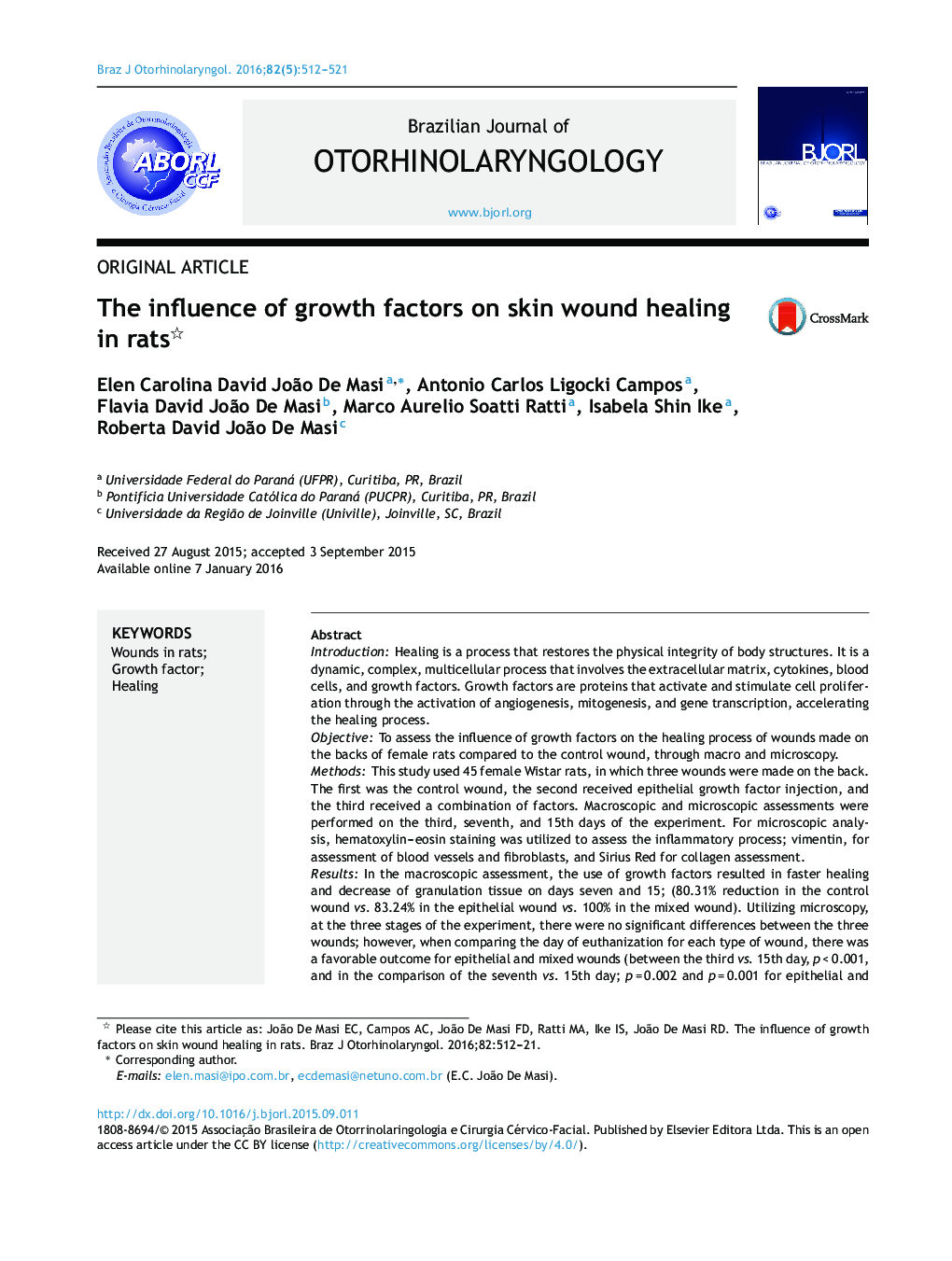| کد مقاله | کد نشریه | سال انتشار | مقاله انگلیسی | نسخه تمام متن |
|---|---|---|---|---|
| 4106055 | 1605359 | 2016 | 10 صفحه PDF | دانلود رایگان |
IntroductionHealing is a process that restores the physical integrity of body structures. It is a dynamic, complex, multicellular process that involves the extracellular matrix, cytokines, blood cells, and growth factors. Growth factors are proteins that activate and stimulate cell proliferation through the activation of angiogenesis, mitogenesis, and gene transcription, accelerating the healing process.ObjectiveTo assess the influence of growth factors on the healing process of wounds made on the backs of female rats compared to the control wound, through macro and microscopy.MethodsThis study used 45 female Wistar rats, in which three wounds were made on the back. The first was the control wound, the second received epithelial growth factor injection, and the third received a combination of factors. Macroscopic and microscopic assessments were performed on the third, seventh, and 15th days of the experiment. For microscopic analysis, hematoxylin–eosin staining was utilized to assess the inflammatory process; vimentin, for assessment of blood vessels and fibroblasts, and Sirius Red for collagen assessment.ResultsIn the macroscopic assessment, the use of growth factors resulted in faster healing and decrease of granulation tissue on days seven and 15; (80.31% reduction in the control wound vs. 83.24% in the epithelial wound vs. 100% in the mixed wound). Utilizing microscopy, at the three stages of the experiment, there were no significant differences between the three wounds; however, when comparing the day of euthanization for each type of wound, there was a favorable outcome for epithelial and mixed wounds (between the third vs. 15th day, p < 0.001, and in the comparison of the seventh vs. 15th day; p = 0.002 and p = 0.001 for epithelial and mixed wounds, respectively) with a higher number of fibroblasts, angiogenesis, and collagen type I.ConclusionThe use of growth factors accelerates healing, stimulates greater angiogenic activity, and accelerates fibroplasia and collagen maturation.
ResumoIntroduçãoA cicatrização é um processo de restauração da integridade física das estruturas do corpo. É um processo dinâmico, complexo, multicelular que envolve matriz extracelular, citosinas, células sanguíneas e fatores de crescimento. Os fatores de crescimento são proteínas que estimulam e ativam a proliferação celular mediante a ativação da angiogênese, mitogênese, transcrição genética, acelerando o processo de cicatrização.ObjetivoAvaliar a influência dos fatores de crescimento no processo cicatricial de feridas realizadas no dorso de ratas em comparação com a ferida, controle através da macro e microscopia.MétodoForam utilizadas 45 ratas Wistar, submetidas à criação de três feridas no dorso. A primeira controle a segunda com injeção de fator de crescimento epitelial e a terceira com fator misto. As avaliações macroscópicas e microscópicas foram realizadas no 3°, no 7° e no 15° dia do experimento. Para análise microscópica, utilizou-se coloração de Hematoxilina-Eosina para avaliar o processo inflamatório; vimentina, para a avaliação dos vasos e fibroblastos, e Sirius Red, para avaliar o colágeno.ResultadosNa avaliação macroscópica, o uso de fatores de crescimento proporcionou cicatrização mais rápida e diminuição do tecido de granulação no 7° e 15° dia; (80,31% de redução na ferida controle vs. 83,24% na ferida epitelial vs. 100% na ferida mista). Na microscopia, nos três momentos do experimento, não foram encontradas diferenças significativas entre as três feridas; entretanto, quando comparados os dias de morte em relação a cada tipo de ferida, observou-se resultado favorável para as feridas epiteliais e mistas (entre 3°×15° dia apresentou p < 0,001 e na comparação entre 7°×15° dias; p = 0,002 e p = 0,001 para as feridas epiteliais e mistas) com maior número de fibroblasto, angiogênese e colágeno tipo 1.Conclusãoa utilização de fatores de crescimento acelera a cicatrização, estimula maior atividade angiogênica, acelera a fibroplasia e maturação do colágeno.
Journal: Brazilian Journal of Otorhinolaryngology - Volume 82, Issue 5, September–October 2016, Pages 512–521
